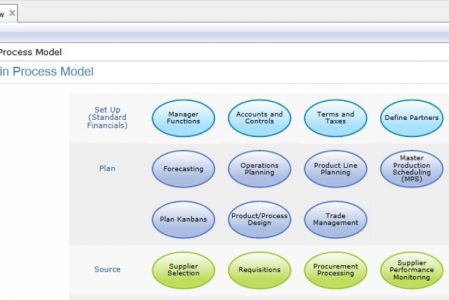When an organization invests in an ERP system like QAD, it is looking for a tool that allows it to support the execution business processes, and to generate information that allows it to make decisions. These business processes are, for the most part, executed by the organization’s human resources. A necessary condition for the company to be successful is that the users of their business software are effective.
Effective: Adj. Successful in producing a desired or intended result.
For users to be effective they need to master two different aspects:
- Process: Which steps to execute, and in what order.
- Content: What is the relevant information is needed to accurately reflect business operations in the system.
In many cases, companies must follow prescribed processes that demonstrate their adherence to process, quality, or regulatory standards – e.g., ISO Certifications.

Traditionally this kind of information is maintained in multiple disparate sources: training guides, work instructions, processes flows, etc. In most cases, this information is not organized in a way that combines process and content and is available in the context of the operations that are being executed.
Enter QAD’s process maps. When first installed they will display “standard” process maps built around QAD programs. They illustrate different views of how to use QAD but they are necessarily generic. They do provide a glimpse into what the functionality can become.
Process maps’ added value is the ability to reflect how QAD supports your own business processes and provides context to users by adding links to internal documents, external media, and relevant websites. Your users can execute the processes they are responsible right from the process maps – and at the same time can have access to the documentation that provides them insight on the data contents and context of the programs they are executing. The combination of process and content has many possibilities:
- A new user can use the maps as a training guide, accessing relevant information to each step from the process map itself.
- A seasoned user can confirm his knowledge in case he has questions about a specific field or process.
- Users responsible for processes that are seldom executed can get a refresher before starting.
- Backup resources can easily fill in for the primary users.
- Auditing and certification requirements can be satisfied.
Process maps are a powerful tool that allow you to help your users, novices and experienced alike, have key information about the business process they are trying to execute at their fingertips. Combined with other functionality such as Configured Screens, Browses and Browse Collections, they go a long way to empowering your users.
A key to releasing the power of process maps is to learn how to create or update them so they fit your needs.
Come and join us for a Webinar on December 17th at noon EST to learn about the basics of how to leverage the power of process maps to help your users be more effective.
Topic: Enabling the Effective QAD user: Process Maps
Date/Time: December 17th @ 12 pm EST
Cost: Free
Carlos Colmenares is a Principal Consultant with Sungate Solutions; he has been assisting users since the 90’s. You can contact him at ccolmenares@sungate-solutions.com .


